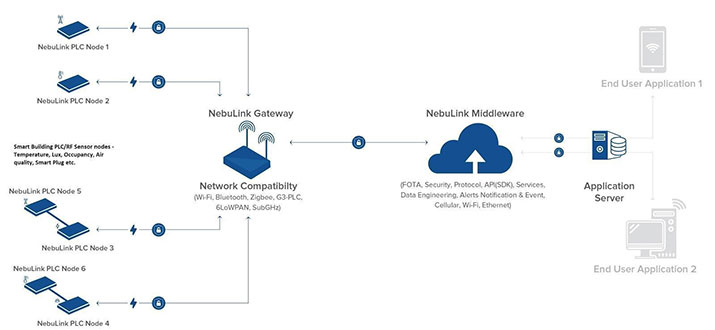Smart Building PLC Testbed Leveraging IoT Network Technologies
IEEE 1901 standard for narrowband Power Line Communications (PLC) over indoor and outdoor electrical wiring supports data rates of up to 500 kb/s. Also, recent amendments like IEEE 1901a-2019 provides enhancements for the Internet of Things (IoT) applications.
There are many worldwide successful PLC deployments for smart grid applications such as smart metering, substation automation, street lighting, BMS, EV charging infrastructure, etc.
In India, there are small-scale PLC deployments such as the AMI pilot project by Tripura State Utility[1]. However, the potential of PLC in the modern context of IoT and other application domains such as smart grid deployments is not fully exploited in India. IEEE Standards Association (IEEE SA) under the Industry Connections (IC) Activity has initiated a program towards setting up multiple Power Line Communications (PLC) testbeds in India engaging various stakeholders from Industry, Academia, and Utilities. In this article, we report how companies can leverage PLC for a smart building use case that is being executed as part of the IEEE PLC Testbed in India initiative.
Smart Building Systems
Building systems are a significant source of energy consumption. Traditional ways of monitoring and control rely on centralized schemes, which have become obsolete. The world is moving towards distributed systems, assisted by significant advances in IoT enabled sensing technologies. The need is to combine the vital information from the IoT smart building sensing platforms, with a novel mathematical framework exploiting optimization theory and machine learning, to control a distributed network of HVAC nodes optimally. To handle the computational burden arising from this big data, we need to exploit cloud computing tools for fast and energy-efficient processing. Power Line Communication (PLC) is a technology that enables data communication over power cables. This means that two devices connected by electrical power cables can simultaneously be powered up and, once switched on, communicate via the connecting wires. In general, wired communication is more reliable than wireless with PLC supporting two-way communications. Networks based on PLC will provide electricity network operators with intelligent monitoring and control capabilities without any additional network cabling. Operators will monitor electricity consumption throughout the grid in real-time, implement variable tariff schedules, and set limits on electricity consumption to manage peak loads better.
Building systems, especially commercial ones, for long have been argued to be one of the best suited to provide ancillary services to manage demand-supply mismanagement in the electric grid. To enable any building, systems must be equipped with smart monitoring systems coupled with efficient control and optimization techniques. In our Smart Building PLC pilot deployment jointly being executed by ERNET India, IIT Madras, SLS Pvt. Ltd., and STMicroelectronics, we have developed a low power multisensory platform, comprising air quality, visibility, sound, temperature, occupancy sensors integrated with PLC technology (which is well suited to work in an indoor building environment) forming the backbone of communication modules to create a “nervous system” for building system environments.
Smart Building PLC Testbed

Figure 1: Smart Building PLC Testbed Deployment Architecture.
As shown in Figure 1, our smart building deployment comprises Power Line Communication sensor nodes to measure temperature, indoor air quality, luminosity, PIR sensor for occupancy detection, smart plug to measure power consumption data. The PLC end node transmits sensor data to a cloud server using the Nebulae IoT platform[2], an interoperable framework to integrate various IoT applications. The components in the Nebulae platform include NebuLink Middleware, NebuLink Nodes, and NebuLink Gateways. The NebuLink Node is a PLC or Wireless Edge device equipped with IPv6 connectivity for sensors and devices. The NebuLink Gateway provides seamless cloud connectivity for the IoT end-nodes implementing heterogeneous IoT technologies like 6LoWPAN, ZigBee, PLC, LoRa, and WiFi. The NebuLink middleware component provides SDK interfaces to IoT end-nodes and gateways for ease of application development in helping with connecting, operating, and automating IoT device management using a single platform. The middleware platform supports secure operations, embedded control, sensing, and easy device management. Various application layer protocols for cloud connectivity such as MQTT, RESTful APIs, and WebSocket are supported. The PLC nodes used in our deployment are based on ST8500 SoC[3] that supports a programmable PLC model compliant with FCC, CENELEC, and ARIB regulations. It supports PLC protocols such as PRIME and G3-PLC with a signal bandwidth up to 500 kHz. ST8500 has an ARM CORTEX M4 core having analog and digital front ends supporting the integration of communication interfaces other than PLC as well. This makes it ideal for applications where PLC and RF may also be required simultaneously as in building controls and monitoring.
Analyzing the Smart Building Data
Building systems comprise a major portion of the total energy demand in India. Conventional Diesel based generators were traditionally employed to meet the additional demand for energy, at enormous environmental costs. With real-time information, our multi-sensory platform enables us to optimize operations by freeing up capacity by improving buildings' energy efficiency. A cloud-based platform enables fusion and visualization of data generated via different sensors. The real-time data generated is used to predict or detect occupancy, fault detection and in some cases also predict and prevent faults from occurring by incorporating appropriate data-driven techniques and finally design optimization algorithms to reduce maintenance costs and overall energy consumption, without compromising user comfort. Finally, to allow remote decision making and control, a dashboard and an Android-based application enable the user to monitor various parameters and quantities related to the overall building environment.
A smart building automation system will help increase energy efficiency and create a healthy environment for its users. This setup increases productivity as it continually monitors building use and adapts the techniques to ensure that the users get the facilities they need. The data generated provides critical insights that help planning and efficient usage of the resources. With a long-term analysis of the data generated, problems can be solved even before they occur, thus saving much time. Our further work would involve exploring opportunities for the deployment of PLC based smart building solutions in some of India's government buildings.
 Vaishnavi Rajini Mohan is an intern at IITM / ERNET working on the project Smart Building PLC Testbed leveraging IoT network technologies. She has completed B.Tech in Computer Science from Amrita Vishwa Vidyapeetham, and is looking to pursue a career in data science.
Vaishnavi Rajini Mohan is an intern at IITM / ERNET working on the project Smart Building PLC Testbed leveraging IoT network technologies. She has completed B.Tech in Computer Science from Amrita Vishwa Vidyapeetham, and is looking to pursue a career in data science.
 Krunal Patel is an Embedded Product Architect and Manager with over 14+ years of developing embedded products from concept to functional prototypes. His experience lies in identifying optimum technologies for architecture and design of solutions encompassing a complete life cycle in the areas of Renewable Energy, Consumer Electronics, Traffic system, Medical, Smart grid, Industry 4.0 based factory automation, building, and home automation.
Krunal Patel is an Embedded Product Architect and Manager with over 14+ years of developing embedded products from concept to functional prototypes. His experience lies in identifying optimum technologies for architecture and design of solutions encompassing a complete life cycle in the areas of Renewable Energy, Consumer Electronics, Traffic system, Medical, Smart grid, Industry 4.0 based factory automation, building, and home automation.
 Manoj Kumar is Director of System Research and Applications at STMicroelectronics, India providing a worldwide mission to build and support reference designs and system solutions in the areas of Connectivity (BLE, Sub GHz, Power Line Communication), Metering, Motor Control, Power & Lighting, and IoT. He is also leading ST Partner Program in India with a mission to provide global visibility to Indian partner companies.
Manoj Kumar is Director of System Research and Applications at STMicroelectronics, India providing a worldwide mission to build and support reference designs and system solutions in the areas of Connectivity (BLE, Sub GHz, Power Line Communication), Metering, Motor Control, Power & Lighting, and IoT. He is also leading ST Partner Program in India with a mission to provide global visibility to Indian partner companies.
 Ramkrishna Pasumarthy is an associate professor at the Department of Electrical Engineering, and the Robert Bosch Center of Data Science and AI IIT Madras India. His research interests are in the area of Network Science, Data Driven Control, and the Internet of Things. He is also a co-founder of iMov motiontech, a startup that produces wearable devices for healthcare applications.
Ramkrishna Pasumarthy is an associate professor at the Department of Electrical Engineering, and the Robert Bosch Center of Data Science and AI IIT Madras India. His research interests are in the area of Network Science, Data Driven Control, and the Internet of Things. He is also a co-founder of iMov motiontech, a startup that produces wearable devices for healthcare applications.
 Paventhan Arumugam is Director of R&D at ERNET India (under Ministry of Electronics & IT) who is also chair of the IEEE-SA industry connections activity on PLC Testbed in India. He has interests in building practical IoT systems leveraging interoperable standards and protocols.
Paventhan Arumugam is Director of R&D at ERNET India (under Ministry of Electronics & IT) who is also chair of the IEEE-SA industry connections activity on PLC Testbed in India. He has interests in building practical IoT systems leveraging interoperable standards and protocols.
Sign Up for IoT Technical Community Updates
Calendar of Events
IEEE 8th World Forum on Internet of Things (WF-IoT) 2022
26 October-11 November 2022
Call for Papers
IEEE Internet of Things Journal
Special issue on Towards Intelligence for Space-Air-Ground Integrated Internet of Things
Submission Deadline: 1 November 2022
Special issue on Smart Blockchain for IoT Trust, Security and Privacy
Submission Deadline: 15 November 2022
Past Issues
September 2022
July 2022
March 2022
January 2022
November 2021
September 2021
July 2021
May 2021
March 2021
January 2021
November 2020
July 2020
May 2020
March 2020
January 2020
November 2019
September 2019
July 2019
May 2019
March 2019
January 2019
November 2018
September 2018
July 2018
May 2018
March 2018
January 2018
November 2017
September 2017
July 2017
May 2017
March 2017
January 2017
November 2016
September 2016
July 2016
May 2016
March 2016
January 2016
November 2015
September 2015
July 2015
May 2015
March 2015
January 2015
November 2014
September 2014


